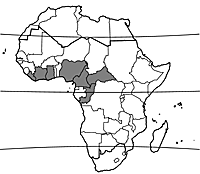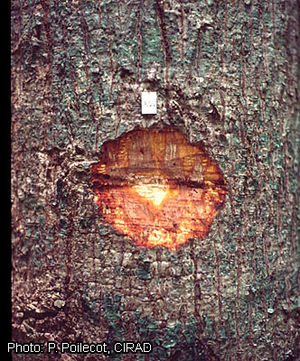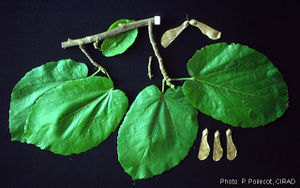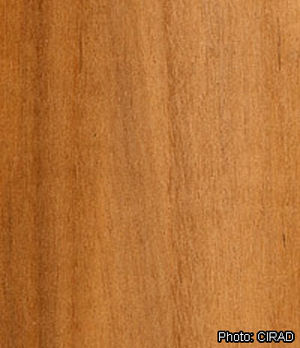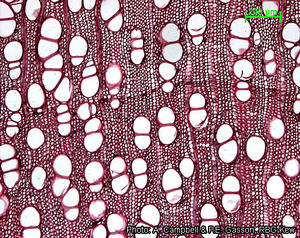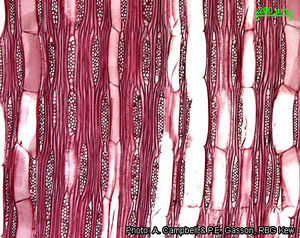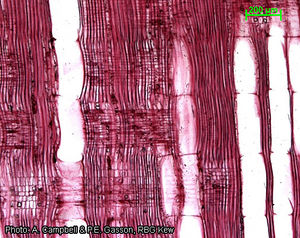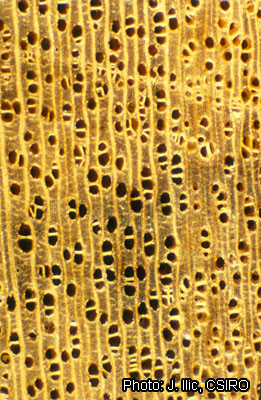Mansonia altissima (PROTA)
Introduction |
| General importance | |
| Geographic coverage Africa | |
| Geographic coverage World | |
| Medicinal | |
| Timber | |
| Ornamental | |
| Forage / feed | |
| Conservation status | |
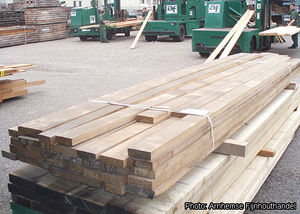
Mansonia altissima (A.Chev.) A.Chev.
- Protologue: Bull. Soc. Bot. France 58, Mém. 8: 138 (1912).
- Family: Sterculiaceae (APG: Malvaceae)
- Chromosome number: 2n = 48
Vernacular names
- Mansonia, African black walnut, African walnut (En).
- Bété, mansonia (Fr).
Origin and geographic distribution
Mansonia altissima occurs from Guinea and Côte d’Ivoire east to the Central African Republic and northern Congo.
Uses
The wood (trade names: mansonia, bété, African black walnut, pruno) is used for general and high-class joinery, cabinet work, furniture, turnery, decorative veneer and handicrafts. It is also used in construction for doors and windows, in railway coaches and shop fittings, and for boxes and crates. Well-coloured wood resembles American black walnut and is commonly used as a substitute, e.g. for gun stocks and grips, musical instruments and loudspeaker enclosures.
Wood waste can be used as a substrate for the edible fungus Pleurotus tuber-regium. Preliminary observations indicate that the fermented substrate has some value as cattle feed.
The bark is very poisonous and in parts of south-western Côte d’Ivoire it is the main component of a very effective arrow-poison, also used in spear traps for large game. In other parts of its range the bark is a component of arrow poisons too. In Nigeria and Ghana products from the bark have been used in the treatment of leprosy. A bark extract is drunk or an infusion of the root is applied as enema as an aphrodisiac. A root decoction is given as enema against leprosy. A decoction of the twig bark is applied as a bath against yaws, scabies and syphilis.
Production and international trade
The wood of Mansonia altissima was first exported from Nigeria in the 1930s as a substitute for walnut; at that time the sustainable annual yield was estimated to 4800 m³ per year. Between 1959 and 1970, however, Nigeria exported 15,500 m³ of logs and 800 m³ of sawn wood per year. Côte d’Ivoire exported about 131,400 m³ of logs and 2700 m³ of sawn wood per year in 1967–1972. In 1994 Côte d’Ivoire exported 314 m³ of veneer. Ghana exported 2700 m³ of logs in 1998 and only 300 m³ of logs in 2000 and in 2001. In 2004 Ghana exported 1000 m³ of plywood at an average price of US$ 367/m³. Cameroon exported 1900 m³ of sawn wood in 2003. Europe and the United States are the main importers.
Properties
The heartwood is yellowish brown to dark grey-brown or even dark brown, often with purple, reddish or greyish green streaks, often in alternating light and dark bands. It fades on exposure to a somewhat dull brown. It is distinctly demarcated from the 2–4(–6) cm wide, white to pinkish sapwood. The grain is usually straight, texture fine. The wood is moderately lustrous.
The wood is of medium weight with a density at 12% moisture content of 590–720 kg/m³. It dries fairly rapidly with little distortion or degrade. In Congo it takes about 15 weeks to air dry boards 5.5–6 cm thick from 75% to 23% moisture content. Shrinkage from green to oven dry is (2.6–)4.1–5.7(–7.0)% radial and (5.2–)7.1–9.7% tangential. Movement in service is medium.
At 12% moisture content the modulus of rupture is (61–)114–177(–183) N/mm², modulus of elasticity 9320–12,800 N/mm², compression parallel to grain 43–68(–96) N/mm², shear 6–15 N/mm², cleavage 9–23 N/mm, Janka side hardness 5690–7470 N and Janka end hardness 5740–7470 N.
The wood is easy to work with hand and machine tools with little or only moderate blunting effect on cutting edges and no charring. The surface can be worked to a good finish. The wood holds nails and screws fairly well, but iron tends to corrode in contact with the wood. Gluing properties are good. The wood takes stain and polish well. The wood peels well, but requires softening beforehand; veneer is rather fragile. Steam-bending is easy unless knots are present.
The heartwood is very durable, being resistant to fungi, borers and termites; in logs the sapwood is susceptible to pinhole borer and longhorn beetle attacks. The heartwood is extremely resistant to impregnation with preservatives, sapwood is permeable.
In processing the wood causes high levels of dust, and it may cause serious health problems to workers. The dust may cause dermatitis, nose-bleeding, throat irritation, asthma and eczema, the reactions becoming stronger on repeated exposure. Heart troubles have also been reported. Pigs given the sawdust as litter developed severe contact dermatitis and piglets even died. The toxins in the wood, even in the form of thin veneer, are resistant to oxidation and are heat-stable; they remain effective for many years.
An ethanolic extract of the wood showed hepatotoxic and haematotoxic effects when administered orally to rats. Ethanol and chloroform extracts of the bark have shown a very strong toxicity against several mammals. Extracts of the bark also inhibit the growth of Mycobacterium tuberculosis. Because of its antibacterial properties, addition of small amounts of bark to the diets of chicken, as a substitute of commercial antibiotics, improved feed conversion rates.
The bark contains the highly toxic compound mansonine, related to cardenolides from Digitalis and ouabain from Strophanthus. Its aglycon was identified as strophanthidin. In addition some 30 toxic glycosides have been identified.
From the wood similar glycosides, an azulene derivative, and a range of quinones, called mansonones A–I and L, have been isolated. Mansonone A is the main causal agent of the allergic reaction to the sawdust. The seeds too contain a large number of cardenolide glycosides, including glycosides of strophanthidin and nigrescigenin. The glycosides strophothevoside and strophalloside are about as toxic to mammals as ouabain.
Description
- Evergreen medium-sized to fairly large tree up to 45 m tall; bole branchless for up to 30 m, up to 100(–150) cm in diameter, generally straight, cylindrical, sometimes with narrow buttresses; bark surface fissured lengthwise, clear brown, inner bark yellowish; crown small, ovoid, dense, with branches almost horizontal, later drooping; branchlets hairy or glabrous.
- Leaves alternate, simple; stipules present, early falling; petiole 2–5 cm long, hairy; blade obovate to orbicular, 15–30 cm × 8–15 cm, cordate at base, rounded and sometimes short-acuminate at apex, margin slightly wavy or toothed, papery, densely hairy below, with 6–7 basal veins and 4–5 pairs of lateral veins.
- Inflorescence a large, stalked, terminal cyme 12–15 cm long, densely short-hairy, many-flowered.
- Flowers bisexual, fragrant; pedicel c. 7 mm long; calyx c. 1 cm long, split unilaterally, folded back, stellate hairy; petals 5, obovate, c. 12 mm × 6 mm, glabrous, white, twisted in bud; androgynophore well-developed, c. 18 mm long; stamens 10 in a single circle, nearly sessile; staminodes 5, scale-like; ovary superior, consisting of 5 free carpels, velvety hairy, each carpel with a threadlike, flexuous style with minute stigma.
- Fruit consisting of 1–2 (–3) ovoid nuts c. 0.5 cm in diameter, surface reticulate, with a large papery wing 5–6 cm × c. 2 cm.
- Seedling with epigeal germination.
Other botanical information
Mansonia comprises 4 or 5 species, 2 in Africa, 1 in India and 1 in Myanmar and Thailand. In Mansonia altissima 2 varieties are recognized: var. altissima occurring from Liberia to Nigeria, and var. kamerunica Jacq.-Fél. which occurs from Nigeria east to the Central African Republic. The latter is characterized by glabrous branchlets. Mansonia nymphaeifolia Mildbr., which is endemic to Cameroon, is doubtfully different from Mansonia altissima var. kamerunica.
Mansonia diatomanthera
Mansonia diatomanthera Brenan is a large tree known only from 2 or 3 locations in Tanzania. The use of its wood has not been recorded, but a bark infusion is used as a bath to treat scabies. Mansonia diatomanthera is critically endangered.
Anatomy
Wood-anatomical description (IAWA hardwood codes):
- Growth rings: (1: growth ring boundaries distinct); (2: growth ring boundaries indistinct or absent).
- Vessels: 5: wood diffuse-porous; 13: simple perforation plates; 22: intervessel pits alternate; 23?: shape of alternate pits polygonal); 24: intervessel pits minute (≤ 4 μm; 30: vessel-ray pits with distinct borders; similar to intervessel pits in size and shape throughout the ray cell; 41: mean tangential diameter of vessel lumina 50–100 μm; 42: mean tangential diameter of vessel lumina 100–200 μm; 47: 5–20 vessels per square millimetre; (48: 20–40 vessels per square millimetre).
- Tracheids and fibres: 61: fibres with simple to minutely bordered pits; 66: non-septate fibres present; 69: fibres thin- to thick-walled.
- Axial parenchyma: 76: axial parenchyma diffuse; 77: axial parenchyma diffuse-in-aggregates; 78: axial parenchyma scanty paratracheal; (91: two cells per parenchyma strand); 92: four (3–4) cells per parenchyma strand.
- Rays: 97: ray width 1–3 cells; 106: body ray cells procumbent with one row of upright and/or square marginal cells; 107: body ray cells procumbent with mostly 2–4 rows of upright and/or square marginal cells; 115: 4–12 rays per mm.
- Storied structure: 118: all rays storied; 120: axial parenchyma and/or vessel elements storied; 121: fibres storied.
- Mineral inclusions: 136: prismatic crystals present; 137: prismatic crystals in upright and/or square ray cells; (138: prismatic crystals in procumbent ray cells); (140: prismatic crystals in chambered upright and/or square ray cells); (141: prismatic crystals in non-chambered axial parenchyma cells).
Growth and development
Seedlings attained a height of 1–2 m in 4 years in natural forest and 6 m in 4 years in logged areas. In Kumasi (Ghana) trees attained a bole diameter of 6.5–16 cm and a height of 8–15 m in 10 years. For plantations in Cameroon faster growth has been recorded, with trees growing 2 m in height per year after 2 years decreasing to 1.3 m per year after 10 years. In Côte d’Ivoire mean annual bole diameter growth of Mansonia altissima trees for all diameter classes was 2.5–7 mm. Mean growth for the diameter class 30–50 cm was 5.1 mm per year. An average tree would reach a bole diameter of 50 cm in 90 years.
In Ghana flowering occurs from May to October with a peak in June and fruits ripen in July–April. The fruits are dispersed by wind at the end of the dry season.
Ecology
Mansonia altissima is characteristic of the dense semi-deciduous forest in areas with about 1600 mm annual rainfall and a pronounced dry season. In Côte d’Ivoire the southern limit of its distribution area largely corresponds with the transition of semi-deciduous forest to evergreen forest; to the north its distribution extends to patches of dense forest in the savanna. Seedlings are most common on fertile soils on drier sites; they are fairly drought resistant. Seedlings planted in the wet forest zone died within a few years. In Ghana Mansonia altissima is most common in the semi-deciduous forest of the north-western part of the country, where it occurs mainly in exposed conditions. In southern Ghana seedlings up to 1 m tall are most common in disturbed forest, while smaller seedlings are more common in undisturbed forest. Adult trees are more common in logged or burnt forest than in undisturbed forest.
Propagation and planting
The 1000-seed weight is about 330 g. Germination starts after about 10 days and may take one week, but a dormancy period of several months has also been observed. Dormancy caused little loss of seed viability. Germination occurs under both light and dark conditions, but is strongly depressed in large gaps in the forest. During the first 2 years after germination slight shade stimulates growth and the formation of healthy leaves. Leaves are held vertically in exposed conditions, more horizontally in the shade. After 2 years Mansonia altissima requires full sunlight and it has been classified as a non-pioneer light demander.
Management
Mansonia altissima has been tried in plantations and in enrichment plantings, but no results are known. In Cameroon 420 ha have been planted, and in Côte d’Ivoire 78 ha. It is occasionally retained or grown in agroforestry systems.
Diseases and pests
Ambrosia beetles attack the bole of the standing tree. Caterpillars of the moth Godasa sidae may cause complete defoliation in plantations. Wood-boring caterpillars of Eulophonotus spp. may cause damage to the sapwood. Larvae of the polyphagous grasshopper Zonocerus variegatus may seriously attack the foliage of especially older trees. In plantations they may become serious pests.
Harvesting
The minimum felling diameter is 40 cm in the Central African Republic, 50 cm in Côte d’Ivoire, 60 cm in Liberia and Cameroun, and 70 cm in Ghana.
Yield
A tree 40 cm in diameter yields about 1.8 m³ of timber, trees 50, 60 and 70 cm in diameter yield 2.8 m³, 4.1 m³ and 5.6 m³, respectively.
Handling after harvest
Freshly cut logs are usually too heavy to be transported by river.
Genetic resources
Mansonia altissima is protected by law in Côte d’Ivoire. In Ghana it has been ranked as a pink star species, which means that it is considered common and moderately exploited. In 1984 FAO recommended its in-situ conservation.
Prospects
The wood of Mansonia altissima is likely to remain valuable for furniture and decoration, for which there is a stable market and growing demand. Because reliable statistics on production are lacking, it is not possible to estimate the amounts of Mansonia altissima timber that can be extracted sustainably. Because of its high value, it is recommended to test and include Mansonia altissima in plantation and enrichment programmes or in agroforestry systems.
Major references
- ATIBT (Association Technique Internationale des Bois Tropicaux), 1986. Tropical timber atlas: Part 1 – Africa. ATIBT, Paris, France. 208 pp.
- Aubréville, A., 1959. La flore forestière de la Côte d’Ivoire. Deuxième édition révisée. Tome deuxième. Publication No 15. Centre Technique Forestier Tropical, Nogent-sur-Marne, France. 341 pp.
- Bolza, E. & Keating, W.G., 1972. African timbers: the properties, uses and characteristics of 700 species. Division of Building Research, CSIRO, Melbourne, Australia. 710 pp.
- CIRAD Forestry Department, 2003. Bété. [Internet] Tropix 5.0. http://tropix.cirad.fr/afr/bete.pdf. July 2008.
- Détienne, P., 1975. Nature et periodicité des cernes dans le bois de bété (Mansonia altissima A. Chev). Centre Technique Forestier Tropical, Nogent-sur-Marne, France. 26 pp.
- Durand, P.Y., 1978. Propriétés physiques et mécaniques des bois de Côte d’Ivoire: moyennes d’espèce et variabilité intraspécifique. Centre Technique Forestier Tropical, Abidjan, Côte d’Ivoire. 70 pp.
- Durrieu de Madron, L., 2003. Accroissement diamétrique du bété et de l’iroko. Bois et Forêts des Tropiques 275(1): 83–87.
- Guina, F.G., 1990. Extraction of mansonin from Mansonia altissima as cardiovascular agent (patent application). Ministère de la Recherche Scientifique, Côte d’Ivoire. 35 pp.
- Hawthorne, W.D., 1995. Ecological profiles of Ghanaian forest trees. Tropical Forestry Papers 29. Oxford Forestry Institute, Department of Plant Sciences, University of Oxford, United Kingdom. 345 pp.
- Takahashi, A., 1978. Compilation of data on the mechanical properties of foreign woods (part 3) Africa. Shimane University, Matsue, Japan, 248 pp.
Other references
- Akinagbe, A., Gailing, O. & Finkeldey, R., 2007. Genetic diversity of Mansonia altissima (A. Chev.) and Triplochiton scleroxylon (K. Schum.) in an agroforestry scenario in Akure Forest Reserve, Nigeria. Paper presented at the workshop ‘Utilization of diversity in land use systems: sustainable and organic approaches to meet human needs’, October 9–11, 2007, Witzenhausen, Germany.
- Allgeier, H., Weiss, E. & Reichstein, T., 1967. Die Cardenolide der Samen von Mansonia altissima A. Chev. Helvetica Chimica Acta 50(2): 431–462.
- Ayodele, S.M., Akpaja, E.O. & Anyiador, F., 2007. Evaluation of the yield of Lentinus squarrosulus (Mont) Singer on selected economic tree species. Pakistan Journal of Biological Sciences 10(23): 4283–4286.
- CTFT (Centre Technique Forestier Tropical), 1960. Résultats des observations et des essais effectués au Centre Technique Forestier Tropical sur le Bété, Mansonia altissima A.Chev., Mansonia nymphaeifolia Mildbr. Note Technique No 64. Centre Technique Forestier Tropical, Nogent-sur-Marne, France. 4 pp.
- Estlander, T., Jolanki, R., Alanko, K. & Kanerva, L., 2001. Occupational allergic contact dermatitis caused by wood dusts. Contact Dermatitis 44: 213–217.
- Fernandez-Villamil, S., Dubin, M., Galeffi, C. & Stoppani, A.O.M., 1990. Effects of mansonones on lipid peroxidation, P450 monooxygenase activity, and superoxide anion generation by rat liver microsomes. Biochemical Pharmacology 40: 2343–2351.
- Foahom, P.B., 1990. L’utilization du bété (Mansonia altissima A. Chev., Sterculiaceae) dans l’aménagement et la régénération des forêts du Sud-Cameroun. Bois et Forêts des Tropiques 226: 20–28.
- Foahom, P.B. & Du Merle, P., 1993. Premières données sur la biologie de Godasa sidae (Fab.) (Lep., Noctuidae), un ravageur de Mansonia altissima (Sterculiaceae) au Cameroun. Journal of Applied Entomology 116(3): 284–293.
- Foli, E.G., Alder, D., Miller, H.G. & Swaine, M.D., 2003. Modelling growing space requirements for some tropical forest tree species. Forest Ecology and Management 173: 79–88.
- Galeffi, C., Miranda delle Monache, E., Casinovi, C.G. & Marini Bettòlo, G.B., 1969. A new quinone from the heartwood of Mansonia altissima Chev.: mansonone L. Tetrahedron Letters 40: 3583–3584.
- Grison, F., 1971. Séchage à l’air du Bété (Mansonia altissima) à Pointe-Noire. Centre Technique Forestier Tropical, Pointe-Noire, Congo. 19 pp.
- Gyimah, R. & Nakao, T., 2007. Early growth and photosynthetic responses to light in seedlings of three tropical species differing in successional strategies. New Forests 33(3): 217–236.
- IARC, 1981. IARC monographs on the evaluation of carcinogenic risks of chemicals to humans. The furniture and cabinet-making industry. IARC Monograph 25: 99–138.
- InsideWood, undated. [Internet] http://insidewood.lib.ncsu.edu/search/. May 2007.
- Jonathan, S.G., Fasidi, I.O., Ajayi, A.O. & Adegeye, O., 2008. Biodegradation of Nigerian wood wastes by Pleurotus tuber-regium (Fries) Singer. Bioresource Technology 99(4): 807–811.
- Ogbamgba, K.O. & Wekhe, S.N., 2006. The effect of dietary inclusion of Mansonia altissima on feed intake, feed efficiency, and feed conversion of laying birds and cocks. African Journal of Biotechnology 5(10): 1022–1024.
- Oke, D.O. & Odebiyi, K.A., 2007. Traditional cocoa-based agroforestry and forest species conservation in Ondo State, Nigeria. Agriculture, Ecosystems and Environment 122: 305–311.
- Oliver-Bever, B., 1982. Medicinal plants in tropical West Africa 1. Plants acting on the cardiovascular system. Journal of Ethnopharmacology 5: 1–71.
- Tanaka, N., Yasue, M. & Imamura, H., 1966. The quinonoid pigments of Mansonia altissima wood. Tetrahedron Letters 24: 2767–2773.
- UNEP-WCMC, 2006. Contribution to an evaluation of tree species using the new CITES Listing Criteria. UNEP World Conservation Monitoring Centre, Cambridge, United Kingdom. [Internet]. http://www.unep-wcmc.org/species/tree_study/contents1_en.htm. July 2008.
- Veenendaal, E.M., Swaine, M.D., Lecha, R.T., Walsh, M.F., Abebrese, I.K. & Owusu-Afriyie, K., 1996. Responses of West African forest tree seedlings to irradiance and soil fertility. Functional Ecology 10(4): 501–511.
Sources of illustration
- Aubréville, A., 1959. La flore forestière de la Côte d’Ivoire. Deuxième édition révisée. Tome deuxième. Publication No 15. Centre Technique Forestier Tropical, Nogent-sur-Marne, France. 341 pp.
- Voorhoeve, A.G., 1979. Liberian high forest trees. A systematic botanical study of the 75 most important or frequent high forest trees, with reference to numerous related species. Agricultural Research Reports 652, 2nd Impression. Centre for Agricultural Publishing and Documentation, Wageningen, Netherlands. 416 pp.
Author(s)
- F. Ohene-Coffie, Forestry Research Institute of Ghana (FORIG), University P.O. Box 63, KNUST, Kumasi, Ghana
Correct citation of this article
Ohene-Coffie, F., 2008. Mansonia altissima (A.Chev.) A.Chev. In: Louppe, D., Oteng-Amoako, A.A. & Brink, M. (Editors). PROTA (Plant Resources of Tropical Africa / Ressources végétales de l’Afrique tropicale), Wageningen, Netherlands. Accessed 6 March 2025.
- See the Prota4U database.

